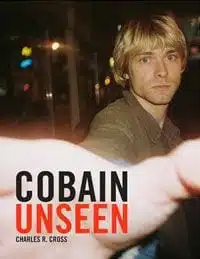
Cobain Unseen is a deeply personal, tactile, even visceral examination of the late, troubled Seattle rock star Kurt Cobain.
Through his artworks and writings, you can see — and, thanks to the many facsimile pullouts, even feel — tangible evidence of the mental and physical torment that plagued Cobain throughout his short life. Suicide was part of his personality from adolescence, the book shows in quotes and writings, so that when he finally does it (in 1994, when his band, Nirvana, was at the height of its fame and popularity), it seems almost inevitable.
The gut aches and back pains he suffered most of his life are played out in drawings and collages of raw meat, bones, skeletons and doll parts; his alienation and escapism are seen in drawings of spindly aliens and references in his writings (including his suicide note) to his imaginary friend, Boddah; the heart-shaped boxes he collected and turned into art objects, mostly as gifts for his wife, Courtney Love, seem to symbolize his empty heart and unfulfilled desire for unconditional love.
But the most moving and heartbreaking elements of Cobain Unseen are the many personal photos, most of which have never been published before. The childhood snapshots of the cute, towheaded, strikingly blue-eyed Cobain show a seemingly happy boy, especially the one where he’s at an easel he got for his 8th birthday, copying the cover of a comic book called Giant-Sized Werewolf #4.
The first time I talked to him, before Nirvana stardom fell down on him, Cobain told me he was more of an artist than a musician. This book makes that readily apparent, as Cobain continued his artwork until his death — even his suicide note can be construed as an artwork.
The childhood photos of Cobain are matched in cuteness by those of his baby girl, Frances Bean Cobain. The few photos in the book that seem to show a content adult Cobain are the ones with him and his baby. And you wonder, how could he ever leave such a beautiful child?
“That’s certainly one of the questions I ask myself,” Cross responded in an e-mail interview, “though it does give me a little more understanding of how troubled he was with his own demons. He clearly loved that kid, and even the photos of Kurt and Courtney indicate a kind of love not seen in previous photos.
“Anyone who understands and knows someone who suffers from addiction — and of course we all know those folks — knows how sad this all is.”
Cross is the only biographer given access, by Cobain’s estate, to his effects, stored in a Seattle warehouse. Cross used much of the material when writing Heavier Than Heaven: A Biography of Kurt Cobain, the definitive biography, published in 2001.
But the text in “Cobain Unseen” isn’t a rewrite of Cross’ earlier book.
“It’s not meant to be a book about new revelations,” Cross explained, “but I think there is a new angle on many of Kurt’s creative accomplishments. Actually, I did about a dozen new interviews for the book, and used a fair amount of stuff I wasn’t able to fit into ‘HTH.’
“But, of course, I couldn’t make the story arc any different. It’s the same life. He’s born in Aberdeen; he dies in Seattle. I did, however, this time focus on the creative work. This is not a biography of Kurt, the man; it is a bio of his art, and that reflects different focus and attention.
“The text is all new, but obviously there are many points in ‘HTH’ that are going to be the same. The newest stuff, however, comes actually in the last chapter or so, which reveals quite a bit of new stuff about Kurt’s last days. Creepy stuff. I, however, didn’t want that to overwhelm the rest of the book, so I didn’t make that chapter longer than the others.”
A CD that comes with the book includes spoken-word material read by Cobain, as well as an interview with Cross about his research for the book.
Cross said he got everything he wanted into “Cobain Unseen,” except for a photo of a naked Love, taken by Cobain.
“I thought she looked great, but she didn’t think so,” Cross wrote in his e-mail. “She obviously had the right to axe that. Nothing else about the book did she censor or ask to change.”
Cross was surprised to find several rolls of undeveloped film among Cobain’s effects. Love told him she didn’t want to see the photos right after Cobain died, but she and Cross had the rolls developed, and many of the photos appear in the book.
“Some of the photos in this book were never seen by anyone other than the photographer through the lens, and sometimes that was Kurt himself,” Cross wrote in the e-mail interview. “That fact amazed me.”
